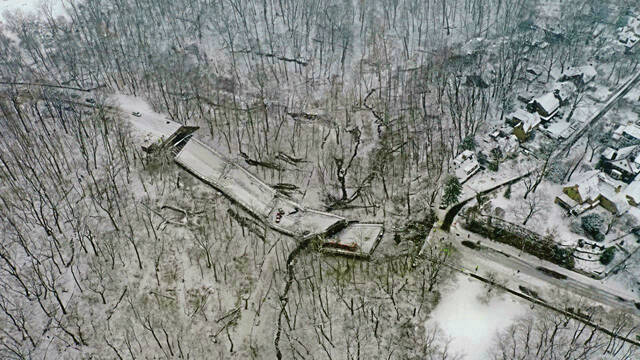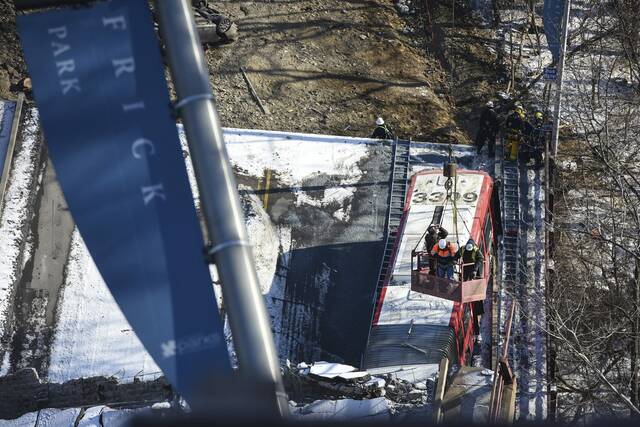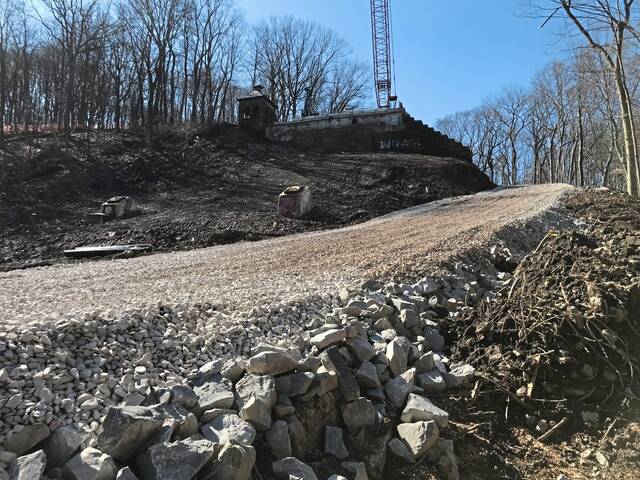What’s the origin of Fern Hollow’s name? Even Pittsburgh historians say it's a mystery
Since the collapse of Fern Hollow Bridge in Frick Park, many Pittsburghers have been asking: What exactly is Fern Hollow?
For one, it’s a ravine in Pittsburgh’s East End that has a creek running through its center. The ravine also partially marks the border between Squirrel Hill and Regent Square. The bridge that carried Forbes Avenue between those neighborhoods shared its name with Fern Hollow, as does the creek that runs through it, Fern Hollow Creek.
The ravine represents the northeastern section of Frick Park, stretching from the Reynolds Street Park in Point Breeze to where Fern Hollow Creek meets with Nine Mile Run near the Lower Frick Park Play Area.
But where does the name come from? Local historians are still trying to figure that out.
Researchers at the Squirrel Hill Historical Society (SHHS) had been gathering information about Fern Hollow prior to the bridge collapse. They increased their efforts after it fell. Through that research, the who, when and why of Fern Hollow’s name remained elusive, said SHHS vice president Helen Wilson.
“Basically, we don’t know the origin of the name yet,” she said.
Many places’ names in Pittsburgh originate from the first land grant property owners, who typically just named places after themselves, Wilson said. But SHHS hasn’t been able to locate any land grant records related to Fern Hollow.
“From the very earliest land grants, ones from the 1700s, we were hoping one of the land grant names would have been Fern Hollow, but it wasn’t,” Wilson said.
David R. Grinnell is coordinator of Archives and Manuscripts at the University of Pittsburgh Library System. There is no indication of the Fern Hollow name on the 1872 Hopkins Atlas of Pittsburgh and other archived maps through 1910, he said.
Back then, much of the land comprising Fern Hollow ravine was owned by James Adams Hutchison. It was later sold to famous Pittsburgh industrialist Henry Clay Frick.
Grinnell said he hasn’t been able to determine exactly where the Fern Hollow name originated.
Pittsburgh Parks Conservancy manages Frick Park, but its spokesperson, Alana Wenk, said no one at the conservancy has uncovered how Fern Hollow got its name.
According to The Frick Pittsburgh museum, which is located near the start of Fern Hollow Creek, the area occupies ancestral lands of Native American tribes of the Haudenosaunee, Lenape, Osage and Shawnee peoples. However, Wilson said, there isn’t evidence that Native Americans specifically settled in Fern Hollow, so it’s unclear whether Native Americans gave the ravine a name.
SHHS researcher Lauren Winkler recently found evidence that the Fern Hollow name is at least over 130 years old. An article in the Pittsburgh Dispatch from August 1890 advertised a picnic at Fern Hollow for Wilkinsburg students. This was the oldest mention SHHS could find.
Another article from the Pittsburgh Press in 1896 mentions that people would walk from the Wilkinsburg train station to Fern Hollow for picnics.
Fern Hollow has largely remained undeveloped throughout its history and has always been revered for its natural beauty, Wilson said. A railroad once was proposed to travel through Fern Hollow, but it was ultimately rejected.
“It always seems to have been a wonderful and scenic place,” Wilson said. “All the references said how beautiful it was. It was always kept in its wild state.”
Although a 1910 Landscape Plan of Frick Park by O.C. Simonds & Company does not indicate a name for the ravine, it shows that “ferns” were to be planted on the west hillside north of a “Steel Arch Bridge,” Grinnell said.
However, the order to plant ferns in the ravine comes at least three decades after mentions of the Fern Hollow name in the local press. It could be that the ravine name was inspired by an abundance of natural fern plants, or early landowners planting ferns there, but Wilson said there is no documented proof of this.
Nick Brungo owns and operates Fern Hollow Bicycles in Wilkinsburg. The bike shop used to be in Lawrenceville and was called Love Bikes, but Brungo said he rebranded when the shop moved about three years ago.
“I rebranded the bike shop because I wanted to feel closer to the neighborhood,” Brungo said.
Still, he said, he doesn’t know where the Fern Hollow name originated.
For many years, Fern Hollow and much of the surrounding area was owned by Frick, the famous Pittsburgh industrialist. Shortly after his death in 1919, more than 150 acres and a $2 million trust fund were bequeathed to the city, with the intent to maintain the land as a public park. Over the years, the city purchased more land and expanded the scope to over 340 acres.
Originally called Frick’s Woods, the park opened in 1927. According to Pittsburgh Parks Conservancy, there is a misconception that most of Frick Park was untouched wilderness. There were Native American hunting trails, pioneer grist mills, Civil War fortifications, and a golf course that dotted much of what Frick Park is today.
Even after Frick Park was established, Nine Mile Run presented pollution problems. Fern Hollow Creek is a northern branch of Nine Mile Run, which meanders through the southern portion of the park. Between the 1920s and 1970s, about 200 million tons of slag were dumped into Nine Mile Run.
Luckily for Fern Hollow, it is upstream of Nine Mile Run and avoided industrialization. In fact, before the bridge collapse, Wilson said, Fern Hollow’s natural state had avoided the same disruption that hit other parts of Frick Park.
Today, Fern Hollow remains mostly free of development and is also home to trails that follow the creek and a popular dog park.
On the west side near the bridge location sits a gatehouse that Wilson said was designed by well-known architect John Russell Pope. It’s made of mica schist rock that is not found in Southwestern Pennsylvania.
SHHS is hoping to preserve the building. Pittsburgh Parks Conversancy said it recently replaced the roof of the gatehouse as a means to preserve the “historical asset.”
Ryan Deto is a TribLive reporter covering politics, Pittsburgh and Allegheny County news. A native of California’s Bay Area, he joined the Trib in 2022 after spending more than six years covering Pittsburgh at the Pittsburgh City Paper, including serving as managing editor. He can be reached at rdeto@triblive.com.
Remove the ads from your TribLIVE reading experience but still support the journalists who create the content with TribLIVE Ad-Free.




